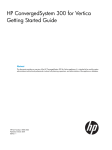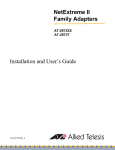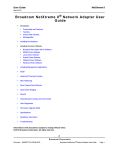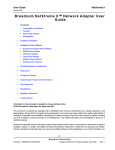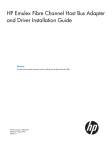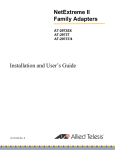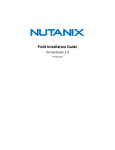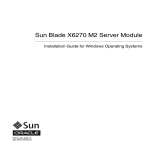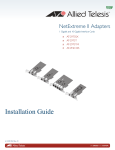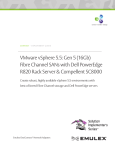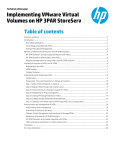Download HP B-Series Remote Replication Solutions Setup and Install
Transcript
HP Boot from SAN Configuration Guide Abstract This document provides information about implementing the high-availability features of boot from SAN in ProLiant servers. It is intended for system administrators who are experienced with storage networks. HP Part Number: 790184-001 Published: January 2015 Edition: 4 © Copyright 2014-2015 Hewlett-Packard Development Company, L.P. © Copyright 2009 Emulex Corporation © Copyright 2009 QLogic Corporation Confidential computer software. Valid license from HP required for possession, use, or copying. Consistent with FAR 12.211 and 12.212, Commercial Computer Software, Computer Software Documentation, and Technical Data for Commercial Items are licensed to the U.S. Government under vendor's standard commercial license. The information contained herein is subject to change without notice. The only warranties for HP products and services are set forth in the express warranty statements accompanying such products and services. Nothing herein should be construed as constituting an additional warranty. HP shall not be liable for technical or editorial errors or omissions contained herein. Acknowledgments Microsoft® and Windows® are trademarks of the Microsoft Group of companies. Contents 1 Introduction...............................................................................................4 Prerequisites.............................................................................................................................4 2 Configuring HBAs.......................................................................................5 Configuring Secure Boot............................................................................................................5 Configuring Emulex HBAs in BIOS environments...........................................................................5 Configuring Emulex HBAs in HP UEFI Environments..................................................................6 Configuring QLogic HBAs in BIOS environments...........................................................................7 Configuring QLogic HBAs in HP UEFI Environments..................................................................8 Configuring Brocade HBAs........................................................................................................9 Configuring Broadcom CNAs.....................................................................................................9 3 Best practices...........................................................................................11 Driver installation and upgrade................................................................................................11 4 Installing the operating system....................................................................12 Emulex, QLogic, and Brocade HBAs.........................................................................................12 Linux ...............................................................................................................................12 Red Hat Enterprise Linux.................................................................................................12 SUSE Linux Enterprise Server...........................................................................................12 Windows..........................................................................................................................12 Installing from the Microsoft CD......................................................................................12 Loading the HBA driver for a Microsoft Windows Server 2003 install...................................13 Installing the Microsoft Windows Server 2003 operating system..........................................13 Installing the Microsoft Windows Server 2008 operating system..........................................13 VMware...........................................................................................................................13 Citrix................................................................................................................................14 Broadcom CNAs....................................................................................................................14 Linux................................................................................................................................14 Red Hat Enterprise Linux.................................................................................................14 SUSE Linux Enterprise Server...........................................................................................15 Windows..........................................................................................................................16 Microsoft Windows Server 2008 SP2/R2.........................................................................16 Microsoft Windows Server 2012/ 2012 R2.......................................................................16 VMware...........................................................................................................................17 VMware Best Practices............................................................................................................17 5 Support and other resources......................................................................18 Contacting HP........................................................................................................................18 HP technical support..........................................................................................................18 Subscription service............................................................................................................18 Documentation feedback....................................................................................................18 Related information.................................................................................................................19 Typographic conventions.........................................................................................................20 A Slipstreaming Broadcom Drivers into Microsoft Windows Server 2012/ 2012 R2 Image Files............................................................................................21 Injecting (Slipstreaming) Broadcom Drivers into Microsoft Windows Server 2012/ 2012 R2 Image Files......................................................................................................................................21 Glossary....................................................................................................24 Contents 3 1 Introduction Traditionally, servers are configured to install the operating system on internal direct-attached storage devices. With external booting from HBAs or RAID arrays, server-based internal boot devices can be eliminated. Booting from an external device provides high-availability features for the operating system during the boot process by configuring the HBA BIOS with redundant boot paths. Booting from SAN provides: • Improved disaster recovery • Reduced backup time when the boot path is through a SAN • Additional SAN-managed features Prerequisites To use this document, it is essential to be familiar with the infrastructure of SAN and have knowledge of: • HP Fibre Channel HBAs, CNAs, mezzanine cards, and LOMs • HP Smart Array Controllers • HP disk arrays • HP ProLiant servers and BladeServers • Hardware setup procedures • Fabric administration • Installing an operating system • Virtual connect • iLO • Device Mapper multipath solution (for Linux and Citrix) • Multipath DSM (for Windows) • Server BIOS • The procedure to create and map a LUN on the storage array • The procedure to set up switch zoning • Upgrading server BIOS to the latest released version • Upgrading firmware on all installed cards to the latest version For up-to-date information on supported versions of firmware, BIOS, and drivers, see the HP HBA Support Matrix at http://h20272.www2.hp.com/Pages/spock2Html.aspx?htmlFile=hw_hbas.html& lang=en&cc=US&. It is essential to sign up for HP Passport to enable access. For more information about HP products, see the HP Manuals website at http://www.hp.com/ support/manuals. For more information about SAN configurations, see the HP SAN Design Reference Guide at http://www.hp.com/go/sdgmanuals. 4 Introduction 2 Configuring HBAs NOTE: • Although the procedures in this chapter refer to HBAs, they apply to all supported adapter types (HBA, CNA, LOM, and mezzanine cards). • For Windows servers, only one boot path must be configured. IMPORTANT: HP recommends disabling HBA BIOS on HBAs that are not part of BFS. HBA/CNA/LOM/mezzanine cards provide BFS functionality. When adapters are configured to boot from the disk device on the SAN, the server boots as if the SAN disk were a local disk. More than one adapter can be configured for the redundant boot path for the high availability of the boot device. After the link is established with boot LUN no additional failover is performed. Configuring Secure Boot For the OS variants that support the UEFI Secure Boot feature, see Configuring Secure Boot section in the HP UEFI System Utilities User Guide for HP ProLiant Gen9 Servers manual available at http:// h20628.www2.hp.com/km-ext/kmcsdirect/emr_na-c04398276-2.pdf. To enable this functionality on your server, follow the server configuration guidelines properly. NOTE: • The operating system must support the UEFI Secure Boot option. • The UEFI Secure Boot option is supported on all Proliant Gen9 servers, the DL580 Gen8 servers, and all C-class Gen9 blade servers. For more information on enabling the UEFI secure boot on your server, see the HP UEFI System Utilities User Guide for your server specific platform. Configuring Emulex HBAs in BIOS environments To configure an Emulex boot device for high availability: 1. For specific Emulex product type, press Alt+E or Ctrl+E to enter Emulex FC, FCoE, or ISCSI BIOS as it appears during the boot process to further configure the boot components. 2. Use the up and down arrow keys to navigate the list and select the HBA index number, and then press Enter. The HBA configuration menu appears. 3. Select Configure This Adapter’s Parameters. The Configure Adapter’s Parameters menu appears. 4. Select Enable or Disable BIOS. CAUTION: If BIOS is enabled, ensure at least one valid BFS LUN is configured, as mentioned in Step 8. Otherwise, the next server boot will take significantly long time. 5. 6. 7. 8. Press 1 to enable the BIOS. Press Esc twice to return to the main menu. If not already done, zone and create the boot LUN. Select Configure Boot Devices. The Saved Boot Devices list appears. NOTE: To clear Saved Boot Devices list, enter 00. Configuring Secure Boot 5 9. Use the up and down arrow keys to navigate to the HBA that needs to be set as the primary boot path, and then enter 1. The array WWN and LUN created, appears. 10. At the Select Two-Digit Number of the Desired Boot Device prompt, enter the index of the controller port. 11. When prompted, enter the LUN ID of the starting LUN. 12. When prompted, enter the index of the boot device from the list. 13. Select Boot this device via WWPN. 14. Return to the List of Saved Devices window. 15. Exit from the BIOS menu and reboot the server. 16. • • For servers running Windows: 1. Complete the operating system build. See “Installing the operating system” (page 12). 2. Install multipathing software. 3. Proceed to Step 17. For servers running Linux: 1. Complete the operating system build. See “Installing the operating system” (page 12). 2. If multipathing software is not already configured, configure multipathing software. 3. Proceed to Step 17. 17. Configure alternate paths for boot devices by selecting the unused entries and repeating Step 12 and Step 13. 18. Return to the Emulex Adapters in the System menu. 19. Configure other HBAs by repeating Step 2 through Step 17. Configuring Emulex HBAs in HP UEFI Environments NOTE: The HP UEFI environment may look and behave differently from other OEM providers. To configure an HP-branded Emulex boot device for high availability in legacy BIOS boot mode (HP 81E and HP 82E only): 1. Allow the system to get past the UEFI portion of the boot sequence and enter the legacy BIOS boot module. The system should display the BIOS-style device banners at this point. 2. Follows the steps under “Configuring Emulex HBAs in BIOS environments” (page 5) to complete the configuration process. To configure an HP-branded Emulex boot device for high availability in legacy BIOS boot mode (all other adapters): • These adapters can configure their legacy BIOS mode operation via the UEFI HII interfaces. To configure them, follow the instructions under To configure an HP-branded Emulex boot device for high availability in UEFI boot mode. To configure an HP-branded Emulex boot device for high availability in UEFI boot mode: 1. During system boot, press F9 to enter the system utilities menu. 2. Select System Configuration, and then press Enter. 3. Navigate to one of the desired adapter ports, and then press Enter. The HBAs HII configuration menu should appear. 4. 5. 6. 6 Select Set Emulex Adapter to Default Settings, and then press Enter. Select Set Adapter Defaults, and then press Enter. Select Set Boot from SAN, and change the option to Enable. Configuring HBAs 7. 8. 9. 10. 11. 12. 13. 14. 15. 16. If needed, change the appropriate FCF parameters to connect to your FC/FCoE network. Select Add Boot Device and wait for the adapter to scan and find the bootable targets available on the fabric. Select the desired boot device WWPN, and then press Enter. Select the desired boot LUN, and then press Enter. Select Commit Changes, and then press Enter. Press ESC until you have returned to the HBAs HII configuration menu. Configure additional boot targets by repeating Step 6 through Step 10. Select Change Boot Device Order, to verify that all boot devices are configured and saved correctly and that their boot priority is ordered correctly Press ESC until you have returned to the system configuration menu. Configure all the applicable FC adapter ports in the system by repeating Step 3 through Step 13. Configuring QLogic HBAs in BIOS environments To configure a QLogic boot device for high availability: 1. For specific QLogic product type, press Alt+Q or Ctrl+Q to enter QLogic FC, FCoE, or ISCSI BIOS Utility as it appears during the boot process to further configure the boot components. The Emulex BIOS utility displays Emulex Adapters in the System. 2. Select the HBA to boot, and then press Enter. The Fast!UTIL Options menu appears. 3. Select Configuration Settings, and then press Enter. The Configuration Settings menu appears. 4. Select Adapter Settings, and then press Enter. The Adapter Settings menu appears. 5. 6. 7. Use the arrow keys to select Host Adapter BIOS, and then press Enter to change the setting to Enabled. Press Esc to return to the Configuration Settings menu. Select Selectable Boot Settings, and then press Enter. The Selectable Boot Settings menu appears. 8. 9. Press Enter to enable the Selectable Boot option. Move the cursor to Primary Boot Port Name, LUN, and then press Enter. The Select Fibre Channel Device menu appears. 10. Select the controller Port Name of the array, and then press Enter. The Select LUN menu appears. 11. Select the device from which to boot, and then press Enter. 12. To configure alternate boot paths for Linux servers: a. Return to the Selectable Boot Settings menu. b. Select Boot Port Name, LUN. c. Press Enter to enable the Selectable Boot option. d. Move the cursor to Secondary Boot Port Name LUN, and then press Enter. The Select Fibre Channel Device menu appears. e. Select the controller Port Name of the next array, and then press Enter. The Select LUN menu appears. f. Select the alternate device from which to boot, and then press Enter. Configuring QLogic HBAs in BIOS environments 7 13. Repeat Step 12 for all controller ports in the array. 14. Press Esc twice to save the changes, and then select Save Changes. The configuration changes to the selected HBA are saved. 15. From the Fast!UTIL Options menu, select Select Host Adapter, and then press Enter. Select the other HBAs and repeat Step 2 through Step 14. 16. Press Esc twice to save the changes. Initial setup is complete. 17. Reboot the server. Configuring QLogic HBAs in HP UEFI Environments NOTE: The HP UEFI environment may look and behave differently from other OEM providers To configure an HP-branded QLogic boot device for high availability in legacy BIOS boot mode (HP 81Q and HP 82Q only): 1. Allow the system to get past the UEFI portion of the boot sequence and enter the legacy BIOS boot module. The system should display the BIOS-style device banners at this point. 2. Follows the steps under “Configuring QLogic HBAs in BIOS environments” (page 7) to complete the configuration process. To configure an HP-branded QLogic boot device for high availability in legacy BIOS boot mode (all other adapters): • These adapters can configure their legacy BIOS mode operation via the UEFI HII interfaces. To configure them, follow the instructions under To configure an HP-branded QLogic boot device for high availability in UEFI boot mode. To configure an HP-branded Qlogic boot device for high availability in UEFI boot mode: 1. During system boot, press F9 to enter the system configuration menu. 2. Select System Configuration, and then press Enter. 3. Navigate to one of the desired adapter ports and then press Enter. The HBAs HII configuration menu should appear. 4. 5. 6. 7. 8. 9. Select Adapter Settings, and then press Enter. Reset defaults FC Function. Ensure all the adapter settings match those used by your fibre channel fabric. Select Save Changes. Select Boot Settings, and then press Enter. Select Adapter Driver, and then press Enter. Set it to Enabled and then press Enter. 10. 11. 12. 13. 14. 15. 16. 17. 18. 19. 8 Select Selective Login and set it to Enabled. Select Selective LUN Login and set it to Enabled. Select World Login and set it to Disabled. Select Save Changes, and then press Enter. Press ESC to return to the HBAs HII configuration menu. Select Boot Devices, and then press Enter. Select a free boot device and enter in the desired target WWPN and LUN number. Repeat Step 15 for each target port you wish to connect to with this device. Press ESC until you return to the system configuration menu. For all adapter ports in the system repeat Step 3 through Step 17 Configuring HBAs Configuring Brocade HBAs Enable or disable BIOS for BFS, set port speed, and display HBA BIOS settings using BCU commands. By default, BIOS is enabled on all HBA ports. HP Brocade BIOS Configuration Utility can be utilized , embedded with the boot code, BCU commands, and the HCM to configure BFS. For more information about the procedures, see the Boot Code chapter in Brocade Adapters Installation and Reference Manual available at http:// www.hp.com/support/manuals. Under Storage, click Storage Networking, and then under Host Bus Adapters, select your product. To configure a Brocade boot device for high availability: 1. Enable BIOS. BIOS is enabled by default. However, BIOS must be disabled for arrays that are not configured for BFS. 2. Enable one of the following boot LUN options. • Auto Discover—When enabled, boot information, such as the location of the boot LUN, is provided by the fabric. This is the default value. • Flash Values—The HBA obtains the boot LUN information from flash memory. • First LUN —The host boots from the first LUN visible to the HBA that is discovered in the fabric. NOTE: 3. HP recommends not use the First LUN option. Select a boot device from discovered targets. Configuring Broadcom CNAs To configure a Broadcom boot device for high availability: 1. Update server BIOS with the latest version to ensure that the BIOS supports boot from SAN features. NOTE: 2. 3. 4. 5. Boot from SAN feature is NOT available for supported servers using AMD processors. During POST, press Ctrl-S at the Broadcom NetXtreme Ethernet Boot Agent banner to invoke CCM UI. This displays Broadcom Adapters in the system. Use the navigation keys to select the device for which boot protocol is to be configured and then press Enter. Select Device Hardware Configuration and press Enter. Ensure that DCB Protocol is enabled on the device and correct Storage Personality is configured based on the boot protocol being configured. Press Esc. NOTE: FCoE boot is only supported on DCB enabled configurations. 6. 7. 8. 9. 10. 11. Select MBA Configuration, and press Enter. Configure Boot Protocol field to FCoE and press Esc. Select FCoE Boot Configuration and press Enter. Select Target Information and press Enter. From the list, select the first available path and press Enter. Set the connect parameter to Enabled. Enter the target WWPN and Boot LUN ID for the target to be used for boot. 12. Note down the initiator WWPN seen at the bottom of the Target information screen. 13. Press Esc till prompted to exit and save changes. Configuring Brocade HBAs 9 14. Provision Storage Access in the SAN Storage access consists of zone provisioning and storage-selective LUN presentation, each of which is commonly provisioned per initiator WWPN. The two options available for storage access are: a. Pre-provisioning – To allow the appropriate access for the initiator, manually modify fabric zoning and storage-selective LUN presentation by using initiator WWPN. b. Ctrl-R method – The Ctrl-R method allows the user to apply the boot initiator to carry the link and login into all available fabrics and targets. Using this method, the user can ensure that the initiator is logged into the fabric/target before making any provisioning changes and can provision without manually entering WWPNs. • Allows the system to attempt to boot through the selected initiator. • After the initiator boot starts, it commences with DCBX sync, FIP Discovery, Fabric Login, Target Login, and LUN readiness checks. If the initiator is unable to complete any of these checks , MBA provides the option to press Ctrl-R. PressCtrl-R. • After Ctrl-R is activated, the boot initiator maintains the link and allows the user to make necessary provisioning corrections and complete the check. If needed, modify fabric zoning and make necessary LUN provisioning changes. 15. Proceed to OS installation after storage access is provisioned in SAN. 10 Configuring HBAs 3 Best practices Consider the following: • For Windows, a single path to a single LUN must be created before starting the build process. • Verify the boot order in the server RBSU and ensure that the boot HBA is positioned correctly. • In Microsoft Windows 2008 server, ensure that the USB key is positioned below the hard drive C. • When the build process is complete, BFS driver kit must be upgraded to the full Smart Component driver kit. • Read the release notes for the latest required updates. • Ensure that the HBA management software version is compatible with the driver that is installed. • The Linux driver logs information about fabric or driver events that it detects in the /var/log/ messages file. • Only one LUN can be presented to the server for installation. Multiple paths are acceptable for RH and SLES11, but SLES10 must contain one LUN, one path. • For Windows OS, a separate BFS Driver kit must be available to be installed whenever requested. • Run the latest release version of the SPP before the BFS process is started to update the server BIOS, HBA, CNA, and LOM firmware to the latest released version as recommended by the server installation document for the server type you are installing on. Driver installation and upgrade • The Smart Component creates a log file after the installation is complete. View this log file to verify that the installation was successful. • Look for any yellow warning flags in the device manager. • From the Device Manager, open the HBA device to verify that the driver is running properly. • Use the vendor management utility to verify the driver, firmware, and universal code versions, as well as the driver parameters. Driver installation and upgrade 11 4 Installing the operating system Emulex, QLogic, and Brocade HBAs NOTE: Although the procedures in this chapter refer to HBAs, they also apply to all supported Emulex and QLogic adapter HBA, CNA, LOM, and mezzanine card types. Linux Verify that there are multiple paths to the LUNS before installing a Linux operating system. Red Hat Enterprise Linux 1. 2. Start the installation of the operating system. Provide the parameter linux mpath to the kernel boot line. NOTE: While creating partitions during the installation process, you will see multipath devices (/dev/mapper/mpath*). Create the installation partitions using multipath devices. Multipathing features are enabled for all the operating system partitions created on multipath devices during installation. 3. 4. View the Base System package list and ensure that the device-mapper-multipath package is selected. Complete the installation and boot the server. SUSE Linux Enterprise Server 1. Select the device for installing the operating system: • For SLES 11: 1. Select the DM devices to create installation partitions. By default, DM devices are not listed. To list the DM devices, select Hard Disks. 2. 3. • 2. Select Configure→Configure Multipath→Yes→Yes. Select the DM devices to create installation partitions. For SLES 10, select SAN devices for installation partitions. While creating the installation partitions, select one of the fstab options under Mount in /etc/fstab by: 3. 4. 5. • If you intend to use the user_friendly_names with device mapper multipath devices, select Volume label. • If you do not intend to use the user_friendly_names with device mapper multipath devices, select Device ID. Complete the installation and reboot your server. Verify that the latest supported Device mapper multipath tools package is installed. If you mounted the installation partitions by Device ID in Step 2, ensure that you set the user_friendly_names to no in the /etc/multipath.conf file. Windows Installing from the Microsoft CD Use the following procedures to install the operating system using the Microsoft CD. 12 Installing the operating system Loading the HBA driver for a Microsoft Windows Server 2003 install To load the driver: 1. Insert the HP Smart Setup CD. 2. From the EBSU menu, select Bootable DVD, and then press Enter. 3. Select Load OEM Boot driver or press B to display the Load OEM Boot Driver window. 4. Select the Fibre Channel HBA, and then press Enter. 5. Press Tab once, and then press Enter to load the driver. The system displays a message confirming that the driver is loaded. 6. Select Exit or press X to exit. Installing the Microsoft Windows Server 2003 operating system To install the Microsoft Windows Server 2003 operating system: 1. With the Microsoft Windows Server 2003 CD in the DVD drive, select Bootable DVD. Press any key to boot from the CD and start the installation process. NOTE: 2. 3. Do not press F6 to load any mass-storage device drivers. When the installation completes, use the latest HP Smart Setup CD to update the system drivers and agents. To re-install the HBA driver, run the Smart Component by selecting Drivers→Driver for FC HBA. This sets the HP-supported registry parameters. NOTE: 4. 5. 6. For single-path configurations, skip Step 4. Install multipathing software. Reboot the server to complete the installation. Complete the installation and connect other HBAs, if there are any. Installing the Microsoft Windows Server 2008 operating system To install the Microsoft Windows Server 2008 operating system: 1. With the Microsoft Windows Server 2008 CD in the DVD drive, select Bootable DVD. Press any key to boot the CD which starts the installation process. 2. When prompted, click Custom (Advanced) to install a clean copy of Windows. 3. Browse to the appropriate driver folder. 4. Select the disk on which you want to install the operating system, and then click Next. 5. Use the latest HP Smart Setup CD to update the system drivers and agents. NOTE: 6. 7. 8. 9. For single-path configurations skip Step 4 and Step 6. Install multipathing software. Reboot the server. For multipath configurations, return to the HBA BIOS utility and complete the configuration of the secondary and tertiary boot paths. Reboot the system. VMware 1. 2. 3. 4. Insert the ESXi installer CD/DVD into the CD/DVD-ROM drive or insert the Installer USB flash drive. Restart the machine and follow the on screen prompts. VMware VMvisor Boot Menu appears. Select ESXi installer and press Enter. VMware ESXi Installation Menu appears. Press Enter to continue. Accept VMware EULA appears. Press F11 to accept. Emulex, QLogic, and Brocade HBAs 13 5. 6. 7. 8. 9. Select a Disk to Install VMware ESXi appears. Locate and select the configured in Adapter BIOS and press Enter. Select the appropriate layout of the keyboard and press Enter. Enter the root password, ensure that password must match. Press Enter to continue. Press F11 to confirm the installation. Installation is complete. Remove the installation media and press Enter to reboot. NOTE: For specific ESX/ESXi 3.x, 4.x, and 5.x installation documentation, see http:// pubs.vmware.com/. Citrix For procedures to install Citrix XenServer, see the version-specific Citrix XenServer Installation Guide available at http://support.citrix.com/productdocs/. Broadcom CNAs Linux Verify that there are multiple paths to the LUNs before installing a Linux operating system. Red Hat Enterprise Linux 1. Anaconda image updates. For RHEL 6.3, two options are available 1. For RHEL 6.3, FCoE boot from SAN requires an updated Anaconda image. The updated image is provided by Red Hat at the following location: http://rvykydal.fedorapeople.org/ updates.823086-fcoe.img For RHEL 6.3, on the installation splash screen, press Tab and in the boot command line add ’dd updates=<URL_TO_ANACONDA_UPDATE_IMAGE>’ options. For details about installing Anaconda update image, see Red Hat Installation Guide Section 28.1.3 https://access.redhat.com/site/documentation/en-US/Red_Hat_Enterprise_Linux/ 6/html-single/Installation_Guide/index.html#sn-boot-options-update 2. For RHEL 6.3, on the installation splash screen click Tab. In the boot command line add the 'dd' option. When asked for Basic Storage Devices/Specialized storage devices, select the Specialized Storage Devices menu then switch Anaconda graphical installer to virtual terminal CLI using (Ctrl+Alt+F2) and enter the following commands before searching for FCoE targets (Replace ethX with name of boot interface port): # ifconfig ethX up # fipvlan -c -s -f "-fcoe" ethX Switch back to Anaconda installer using Ctrl+Alt+F6 and proceed to search for FCoE targets using specialized storage device option. For RHEL 6.4, updated Anaconda is not required. On the installation splash screen, press Tab and in the boot command line, add 'dd' option to boot the command line. 2. 3. 4. Press Enter to proceed. When a message ‘Do you have a driver disk’ appears, enter Yes. Follow the on-screen instructions to choose the Driver Update medium and load an appropriate DUD driver kit. NOTE: 5. 6. 14 The DUD driver kit can be found as a part of HP SPP kit. Proceed with installation after the drivers are loaded. Select Specialized Storage Devices and then click Next. Installing the operating system 7. 8. 9. 10. 11. 12. 13. 14. 15. Click Add Advanced Target. Select Add FCoE SAN and click Add Drive. Select each interface intended for FCoE boot, clear Use DCB, select Use auto vlan, and click Add FCoE disk(s). Ensure that all FCoE-visible disks are seen under ‘Multipath Devices’ or ‘Other SAN Devices’ or both, as appropriate. Repeat steps 8 to 10 for all initiator ports. Click Next and complete the installation. The system reboots after installation is complete. After installation, at the RHEL installer prompt for an initial reboot, press Ctrl+Alt+F2 to enter a shell. Edit /mnt/sysimage/boot/grub/menu.lst and place bnx2x.disable_tpa=1 into the default kernel command. After booting, ensure that all boot path devices are set to start at boot time. TIP: To start all boot devices at the boot time, Set onboot=yes under each network config file in /etc/sysconfig/network-script/<ifcfg-eth0/1/2/3/...> NOTE: For RHEL 6.4 only, edit /boot/grub/menu.lst. 1. Delete all “fcoe=<INTERFACE>:nodcb” parameters from the “kernel/vmlinuz...” line. There must be as many FCoE = parameters as there were FCoE interfaces configured during installation. 2. Insert “fcoe=edd:nodcb” to the “kernel/vmlinuz...” line. NOTE: For RHEL 6.3 and RHEL 6.5 only, edit the kernel command line. Next, when the system boots, edit /boot/efi/EFI/redhat/grub.conf as follows: Replace the fcoe=edd:nodcb parameters from the kernel/vmlinuz... line with single fcoe=<INTERFACE>:nodcb for the boot interface which was configured during installation. On account of a known limitation with RHEL 6.3, RHEL 6.4, and RHEL 6.5, the host will only boot from the last interface listed in the kernel command line. SUSE Linux Enterprise Server HP Gen9 server installation: Follow the HP Proliant Gen9–Series servers (also DL580 Gen8 server) installation instructions from the Link. After you have completed the steps, proceed to step 4. 1. Boot from SLES11 SP2/SP3 installation medium and press F6 on the installation splash screen for driver update disk. Select Yes. In boot options, type withfcoe=1. Select Installation to proceed. 2. Follow the on-screen instructions to choose the Driver Update medium and load an appropriate DUD driver kit. 3. After the driver is updated, select Next to continue with the installation. 4. When requested, click Configure FCoE Interfaces. 5. Ensure that FCoE Enable is set to yes on the 10GbE initiator ports that you want to use as SAN boot paths. 6. To enable each interface for FCoE boot, click Change Settings, ensure that: • FCoE Enable and AUTO_VLAN are set to yes • DCB required is set to no • click Create FCoE VLAN Interface Broadcom CNAs 15 7. The VLAN dialog box appears. Click Yes to confirm triggering automatic FIP VLAN discovery. If successful, VLAN is displayed under FCoE VLAN Interface. If not visible, SAN connectivity and switch configuration must to be verified. NOTE: In case of SLES 11 SP3 in HP FlexFabric environment, you might not see any VLAN with interface name, which is acceptable for this environment. 8. 9. 10. 11. 12. 13. When configuration of all the interfaces is completed, click OK to proceed. Click Next to continue installation. To activate multipath, YaST2 prompt appears and it must be answered appropriately. The prompt appears only if multiple paths to the same LUN are configured. Continue with the installation. Under the Expert tab on the Installation Settings screen, select Booting. Select Boot Loader Installation tab and then select Boot Loader Installation Details. Ensure to have one boot loader entry and delete all redundant entries. Click OK and complete the installation. Windows Microsoft Windows Server 2008 SP2/R2 1. 2. 3. 4. Insert Microsoft Windows Server 2008 SP2/R2 CD in the DVD drive and select Bootable DVD. Press any key to boot the CD for initiating the installation process. When prompted, click Custom (Advanced) for installing a clean copy of Windows. Use a USB flash drive containing full contents of the boot driver folder which can be retrieved by extracting the appropriate driver smart component. When prompted, browse to the boot driver stored in USB flash drive. NOTE: For Broadcom devices, the drivers must be loaded in sequence: first the EVBD driver and then the BXFCoE driver. The FCoE driver cannot be loaded before loading the EVBD driver. 5. Select the appropriate FCoE device when a message “Select the driver to be installed” appears and then, press Next. 6. Select the disk to install the operating system and click Next. 7. To update the system drivers and agents, use the latest HP Service Pack for ProLiant (HP SPP). 8. Install appropriate multipathing software. 9. Reboot the server. 10. To configure multipath, return to HBA BIOS utility and complete the configuration of secondary and tertiary boot paths. 11. Reboot the system. Microsoft Windows Server 2012/ 2012 R2 Microsoft Windows Server 2012/ 2012 R2 Boot from SAN installation requires the use of slipstream DVD or ISO image, introducing the latest Broadcom drivers. To create required Microsoft Windows Server 2012/ 2012 R2 image ISO or DVD, refer to Appendix A “Slipstreaming Broadcom Drivers into Microsoft Windows Server 2012/ 2012 R2 Image Files” (page 21) 1. Insert the newly created DVD or ISO for installing the applicable Microsoft Windows server 2012/ 2012 R2 version. 2. After installing the OS, apply the latest HP Service Pack for ProLiant (HP SPP) for updating the system drivers and agents. 16 Installing the operating system 3. 4. 5. 6. Install appropriate multipathing software. Reboot the server. To configure multipath, start HBA BIOS utility and complete the configuration of the secondary and tertiary boot paths. Reboot the system. VMware NOTE: Boot from SAN is supported on ESXi 5.1 U1, ESXi 5.5, or later. FcoE Boot from SAN requires the latest HP custom install image for ESXi 5.1 U1 or ESXi 5.5 which includes Broadcom FCoE drivers. 1. Boot from the updated ESXi installation image and select ESXi installer when prompted. 2. Follow the instructions on the screen to continue the installation process. 3. Reboot the system. VMware Best Practices • Follow HP recommendation from the specific server booting from a SAN. • Enable and configure the adapter correctly, to allow it to access the boot LUN. • Each host must have access to its own boot LUN only and not others. Use storage system software to ensure the host accesses only its designated LUNs. • Multipathing to a boot LUN on active-passive arrays is not supported because multipathing is not supported by BIOS and is unable to activate a standby path. • SAN connections must be made through a switched topology if the array is not certified for direct connect topology. If an array is certified for direct connect topology, SAN connections can be made directly to the array. NOTE: Boot from SAN is supported for both switched topology and direct connect topology if these topologies are certified for the specific array. • See specific ESX/ESXi 3.x, 4.x, and 5.x installation documentation at http:// pubs.vmware.com/. VMware Best Practices 17 5 Support and other resources Contacting HP HP technical support For worldwide technical support information, see the HP support website: http://www.hp.com/support Before contacting HP, collect the following information: • Product model names and numbers • Technical support registration number (if applicable) • Product serial numbers • Error messages • Operating system type and revision level • Detailed questions Subscription service HP recommends to register the product at the Subscriber's Choice for Business website: http://www.hp.com/go/wwalerts After registering, an email notification of product enhancement, new driver versions, firmware updates, and other product resources will be received. Documentation feedback HP welcomes user feedback. To make comments and suggestions about product documentation, please send a message to [email protected]. All submissions become the property of HP. 18 Support and other resources Related information The following documents and websites provide related information: • HP Brocade Fibre Channel Host Bus Adapters Release Notes • HP Emulex Adapters Release Notes • HP QLogic Adapters Release Notes • HP Broadcom Adapters Release Notes • White papers and best practice documents Table 1 Related documentation websites Topic HP website HBAs and switches http://h18006.www1.hp.com/storage/networking/index.html Storage array systems • http://h18006.www1.hp.com/storage/arraysystems.html • http://www.hp.com/go/storage Multipathing software http://h18006.www1.hp.com/storage/software.html ProLiant servers http://h18004.www1.hp.com/products/servers/platforms/storage.html Rapid Deployment Pack http://www.hp.com/servers/rdp Add server blade • http://h71028.www7.hp.com/enterprise/cache/ 80316-0-0-225-121.html • http://h18004.www1.hp.com/products/blades/components/ c-class-components.html • http://h18004.www1.hp.com/products/blades/components/ c-class-bladeservers.html HP SAN Design Reference Guide http://h18006.www1.hp.com/products/storageworks/san/index.html Additional documentation http://www.hp.com Product information http://www.hp.com/support Related information 19 Typographic conventions Table 2 Document conventions Convention Uses Blue text: Table 2 (page 20) Cross-reference links Blue, underlined text: http://www.hp.com Website addresses Blue, underlined, bold text: [email protected] Email addresses Bold text • Keys that are pressed • Text typed into a GUI element, such as a box • GUI elements that are clicked or selected, such as menu and list items, buttons, tabs, and check boxes Italic text Text emphasis Monospace text • File and directory names • System output • Code • Commands, their arguments, and argument values Monospace, italic text • Code variables • Command variables Monospace, bold text NOTE: 20 Provides additional information. Support and other resources Emphasized monospace text A Slipstreaming Broadcom Drivers into Microsoft Windows Server 2012/ 2012 R2 Image Files Injecting (Slipstreaming) Broadcom Drivers into Microsoft Windows Server 2012/ 2012 R2 Image Files To obtain the correct Broadcom driver, extract appropriate smart component for the applicable Windows Server 2012/ 2012 R2 version from HP SPP kit. To inject broadcom drivers into the Windows image file: 1. Copy driver package to a working directory. For example, copy the driver packages to the following directory: C:\Temp NOTE: The names of the files of your choice for slipstream projects are for examples only. You can specify file and folder names for slipstream project. 2. Inject these drivers into Windows Image (WIM) files using one of the available option: a. For Windows Server 2008 R2 and SP2, install the Windows Automated Installation Kit (AIK). To open AIK kit: • b. Start –> Programs –> Microsoft Windows AIK –> Deployment Tools Command Prompt For Windows Server 2012 R2, install the Windows Assessment and Deployment Kit (ADK). For Windows Server 2012 ADK kit, at an elevated command prompt, locate the “Assessment and Deployment Kit” servicing folder. Location of the folder depends upon ADK kit installation path. NOTE: For windows 2012 R2 deployments ensure that Windows 8.1 DISM 6.3.9600.17029 of the Microsoft Deployment and Integration Toolkit is used 3. At prompt, create a temporary directory and set it as the current directory for all later steps. Enter the following command: md C:\Temp\x cd/d C:\Temp\x 4. To create two subdirectories, enter the following commands: md src md mnt 5. To copy the original DVD into the src subdirectory, enter the following commands: xcopy D:\ .\src /e /c /i /f /h /k /y /q NOTE: In this particular example, the installation DVD is in the D: drive. 6. Enter the following commands: attrib -r .\src\sources\boot.wim attrib -r .\src\sources\install.wim 7. To mount the boot.wim image, enter the following command: dism /mount-wim /wimfile:.\src\sources\boot.wim /index:2 /mountdir:.\mnt NOTE: 8. You must always use “2” for the index value. Enter the following commands to add the below drivers to the currently mounted image: dism /image:.\mnt /add-driver /driver:C:\Temp\evbd.inf Injecting (Slipstreaming) Broadcom Drivers into Microsoft Windows Server 2012/ 2012 R2 Image Files 21 dism /image:.\mnt /add-driver /driver:C:\Temp\bxnd.inf dism /image:.\mnt /add-driver /driver:C:\Temp\bxfcoe.inf dism /image:.\mnt /add-driver /driver:C:\Temp\bxois.inf 9. To unmount the boot.wim image, enter the following command: dism /unmount-wim /mountdir:.\mnt /commit 10. To determine the index of the desired SKU in the install.wim image, enter the following command: dism /get-wiminfo /wimfile:.\src\sources\install.wim For example, Example 1 Index: 1 Name: Microsoft Windows Server 2012 R2 SERVERSTANDARDCORE Example 2 Index: 2 Name: Microsoft Windows Server 2012 R2 SERVERSTANDARD Example 3 Index: 3 Name: Microsoft Windows Server 2012 R2 SERVERDATACENTERCORE Example 4 Index: 4 Name: Microsoft Windows Server 2012 R2 SERVERDATACENTER 11. To mount the install.wim image, enter the following command: dism /mount-wim /wimfile:.\src\sources\install.wim /index:2 /mountdir:.\mnt NOTE: You must always use 2 for the index value. 12. To add the drivers in the dism /image:.\mnt dism /image:.\mnt dism /image:.\mnt dism /image:.\mnt currently mounted image, enter the following commands: /add-driver /driver:C:\Temp\evbd.inf /add-driver /driver:C:\Temp\bxnd.inf /add-driver /driver:C:\Temp\bxfcoe.inf /add-driver /driver:C:\Temp\bxois.inf 13. To unmount the install.wim image, enter the following command: dism /unmount-wim /mountdir:.\mnt /commit 14. To create an .iso file, enter the following command: oscdimg -e -h -m -n -lslipstream -bootdata:2#p0,e,b"C:\Program Files (x86)\Windows Kits\8.1\Assessment and Deployment Kit\Deployment Tools\amd64\Oscdimg\etfsboot.com"#pEF,e,b"C:\Program Files (x86)\Windows Kits\8.1\Assessment and Deployment Kit\Deployment Tools\amd64\Oscdimg\efisys.bin" c:\temp\x\src c:\Temp\Win20xxMOD.iso 22 Slipstreaming Broadcom Drivers into Microsoft Windows Server 2012/ 2012 R2 Image Files NOTE: • Platform is a placeholder for the architecture of the operating system, such as amd64 or x86 that you install. Also, xx in filename is the placeholder for Windows Server OS version. • For other version of Windows with different kit, location of etfsboot.com and efisys.bin might be different. 15. Burn the .iso file to a DVD using a DVD-burning application. 16. Install the applicable Windows Server OS version using the new DVD or .iso created. Injecting (Slipstreaming) Broadcom Drivers into Microsoft Windows Server 2012/ 2012 R2 Image Files 23 Glossary BCU Brocade Configuration Utility. BFS Boot from SAN. CNA Converged network adapter. DCB Data Center Bridging EBSU EFI-Based Setup Utility. EFI Extensible Firmware Interface. FC Fibre Channel. A network technology primarily used for SANs. HBA Host bus adapter. A hardware device that connects the host server to the fabric. HCM Host Connectivity Manager. iLO Integrated lights out. LOM LAN on Motherboard. LUN Logical unit number. An identification scheme for storage disks. MBA Multi-Boot Agent POST Power on Self Test RBSU ROM BIOS Setup Utility. SAN Storage area network. An intelligent infrastructure that connects heterogeneous servers and shared, heterogeneous storage systems. USB Universal serial bus. A serial bus standard used to interface devices. WWN Worldwide name. A unique identifier assigned to a Fibre Channel device. WWPN Worldwide port name. A unique 64-bit address used in a FC storage network to identify each device in a FC network. 24 Glossary
























